|
Charles Babbage's
19th century Difference
Engine might be considered the beginning of complex mechanical calculators'
use in science and engineering. It really was not all that long ago. Massive single-purpose
analog computers were designed and constructed in the middle of the last century
for calculating, among other things, projectile trajectories, multi-body orbits,
electrical circuit functions, nuclear detonations, calculation of mathematical function
tables, and navigation. Eventually electrical computers joined the arsenal of tools
available to significantly reduce the amount of time required to carry out complex
calculations requiring multiple iterations using a range of input variables. Programmable
vacuum tube and then transistorized digital computers expanded the range of applications,
but recall that even by the early 1960s, during the early manned space flight projects,
human "calculators" were employed by NASA, corporations, and universities to turn out reams of pages
of numerical calculations. As is often pointed out, your cellphone has vastly more
computational power than the best computers of the Apollo era.
Analog Computers Solve Complex Problems
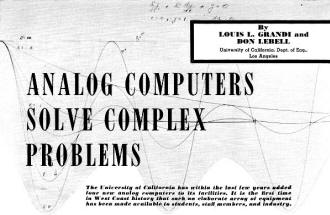 By Louis L. Grandi and Don Lebell By Louis L. Grandi and Don Lebell
University of California, Dept. of Eng., Los Angeles
The University of California has within the last few years added four new analog
computers to its facilities. It is the first time in West Coast history that such
an elaborate array of equipment has been made available to students, staff members,
and industry.
The complex-looking piece of equipment pictured on this month's cover is one
of the four analog computers operated by the Engineering Department of the University
of California on its Los Angeles campus.
Although such equipment is in operation at other locations throughout the country,
this installation is the first on the West Coast. This means that not only can students
receive thorough practical training on this increasingly-important equipment, but
manufacturers in the West Coast area have such facilities immediately available
for the most expeditious handling of their research problems.
The analog facilities include a thermal analyzer, a mechanical differential analyzer,
an electrical differential analyzer, and a network analyzer. These four units comprise
a formidable battery of research weapons in widely diversified fields of endeavor.
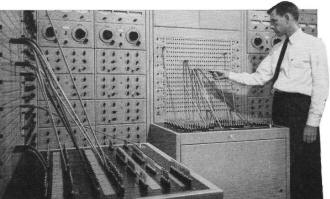
Presenting a problem to network analyzer equipment.
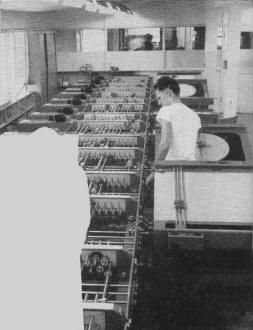
View of University of California differential analyzer.
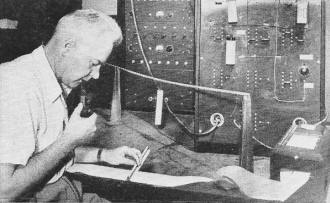
Electronic analog simulating equipment. This is part of the one-hundred
amplifier installation and demonstrates the solution of a simple beam problem. Equipment
was built at University.
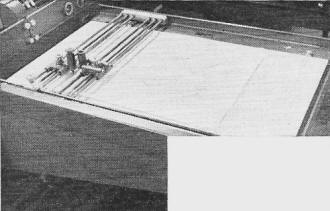
Output table of differential analyzer. "Solutions" appear on
graph paper in the form of curves.

Wheel disc integrator of the mechanical differential analyzer.
A polarized light beam transmits integrator wheel motion directly to the torque
amplifier unit.

Measuring the output data obtained from the mechanical differential
analyzer.
In over-simplified terms, an analog computer is nothing more nor less than a
piece of equipment which can be manipulated in such a way that it duplicates mathematically
the physical problems under study.
Differential Analyzers
The University has two types of differential analyzers - mechanical and electrical.
Basically, both differential analyzers are the same - the function of each varying
only slightly to handle the different requirements.
The electrical differential analyzer is interconnected in accordance with a carefully
prepared schematic diagram. The resulting system thus becomes a physical counterpart
of the mathematical equations being analyzed. Where it is desired to set up a physical
reproduction of an electrical circuit for analysis and study, voltages are used
to represent the terms of the original equation. By varying the voltages, the mathematical
functions of addition, multiplication, integration, and differentiation may be performed
in the circuit. In addition, the analyzer can be used to generate particular functions
within the machine. Components are available in the equipment to supply special
"engineering functions." Output information is obtained from the screen of an oscilloscope.
This particular unit has been used in primary research on transformer equivalent
circuits, to obtain data on relay servomechanisms, and to determine structural characteristics
of critically loaded beams.
In general, the electrical differential analyzer can handle mathematical problems
involving simultaneous, nonlinear differential equations with variable coefficients.
In the realm of physical sciences, the analyzer will handle systems containing nonlinear,
lumped parameters.
The mechanical counterpart of the electrical differential analyzer solves problems
involving physical properties reduced to mathematical equations. This is accomplished
by interconnecting the basic units (integrators, adders, multipliers, etc.) in accordance
with the equations being studied. Unlike the electrical differential analyzer, the
circuit variables are mechanical, thus the actual variables correspond to the angular
displacement of the shafts in the machine.
The equipment features a flexible system whereby the units that perform the basic
operations of addition, subtraction, multiplication, division, and integration can
be interconnected to meet the particular requirements of the problem being studied.
Functions that cannot be expressed as simple mathematical functions can be handled
directly in graphical form by means of special input tables. This feature permits
the solution of problems which contain functions capable of being expressed graphically.
Problems involving the flight and stability of aircraft, airfoil de-icing, landing
gear design, missile trajectory, missile stability design, and stresses in aerodynamically
loaded wings in aeronautics and the field of aerodynamics can be handled by this
unit. In the electrical and electronics fields, this equipment can be used in research
problems arising in the design of pulse transformers, in electron accelerator studies,
in engineering magnetic amplifiers, and in determining electron trajectories. The
fields of oceanography, meteorology, servomechanisms. geophysics, and fluid flow
can all be served by presenting the basic problems to this analyzer.
Network Analyzer
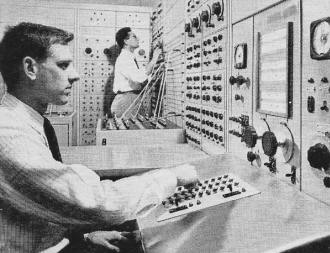
Working a problem on network analyzer.
The University's a.c. network analyzer differs from the differential analyzers
in that it is best suited to the solution of problems by means of physical duplication
of the problems rather than by breaking down the problem into a mathematical formula
and then feeding the problem to the machine.
This unit consists of banks of resistance, inductance, and capacitance elements
which can be varied individually to simulate the circuit conditions of the network
under analysis. In addition to these components, the analyzer contains a number
of generators, a switchboard-type interconnecting system (patch panel), and all
of the meters and testing devices necessary to record the circuit's performance.
For example, in operation a large power system can be duplicated in a limited
space by replacing the various elements of the power system with equivalent electrical
circuits. It can also be used to solve problems where the equivalent circuits consist
of multiple networks of lumped R, L, and C circuit elements.
The network analyzer has proven to be of particular value in handling such problems
as load division, short circuit, and stability in electrical power systems and in
providing the analogs of heat transfer, mechanical vibrations, and in intake and
exhaust gas systems.
Thermal Analyzer
The thermal analyzer was designed and completely constructed by the University's
Department of Engineering. It is used primarily for the solution of heat conduction
problems. Like the network analyzer, it is particularly valuable in cases where
the particular problem can be duplicated physically.
The unit consists of sections of resistance-capacitance elements of different
values which can be connected into the networks and to various types of voltage
and current generators. These generators are used to simulate the heat sources and
impose the boundary conditions of the problem.
Each section of these RC elements contains two independently variable resistors
which are used when two-dimensional heat flow problems are under consideration.
The desired solutions appear in the form of oscilloscope traces or as meter readings.
This analyzer has been used to handle such diversified problems as aircraft icing,
temperature distribution in gun barrels, forest fire control research, foundry studies,
and various phases or melting and freezing processing.
Today the University of California has the research tools required by industry,
pure science, and in basic research and foremost among these tools are the analog
computers which can be used in man's quest for knowledge.
Posted June 12, 2024
(updated from original post
on 9/15/2018)
|

















